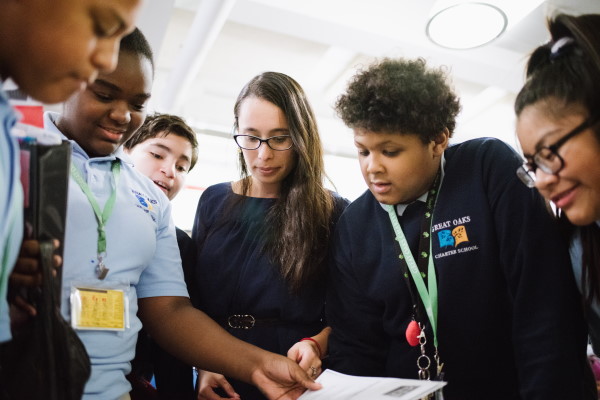The NYU Teacher Residency is structured to immerse teacher candidates in the art and science of teaching. This includes everything from learning classroom management and culturally responsive teaching methods, to practicing inclusive pedagogical techniques.
A critical aspect of the program is that teacher residents get to know and understand what it is like to work with students. Building a positive teacher-student relationship and a student-centered environment are some of the most important parts of becoming a successful educator. One way that the Teacher Residency encourages this is through Participatory Action Research (PAR) projects throughout the immersive year.
What is PAR?
PAR is a research method that involves researchers and participants working together to identify a problem and develop a researched-based solution. “PAR focuses on social change that promotes democracy and challenges inequality; is context-specific, often targeted on the needs of a particular group; is an iterative cycle of research, action and reflection; and often seeks to ‘liberate’ participants to have a greater awareness of their situation in order to take action.” (Institute of Development Studies, 2019)
What does PAR look like in the NYU Teacher Residency?
In the instance of the Teacher Residency, residents act as teacher researchers and come together with students as the PAR team to identify a problem of practice. Residents begin thinking about their PAR projects during the first few months of the residency year. During this time, NYU Steinhardt faculty work to build residents’ foundational knowledge of how different classrooms work, the importance of knowing your community, and how to structure a culture of achievement in individual classrooms.
“The PAR projects are woven throughout the residency year,” said Nada Ahmed, visiting assistant professor of master of arts in teaching, co-director of the NYU Teacher Residency, and director of field studies for NYU Steinhardt. “We aim to connect this collaborative research with other concepts that residents are learning so they can apply the lessons to the PAR. Residents serve as facilitators – collecting data, designing a pilot study, and showcasing findings alongside their students. This alignment of the curriculum, research, and hands-on work in the classroom is an essential component of the Teacher Residency.”
Residents begin the research process by bringing together a group of 10-12 students who will together design and develop the PAR project. As the year progresses, using an equity lens, PAR teams reflect on what they are discovering about the problem of practice. By the end of the year, residents use multimodal learning to showcase learnings and invite the PAR student teams to help share the research either in person and or through video to their Teacher Residency cohort. Some PAR teams will identify ways to continue the research in the following year, and others may create solutions that are implemented each year by the school.
Why does PAR matter?
PAR is a powerful and practical way to involve students in a range of challenges that schools experience today. These challenges may be academic, such as how to make math more fun, what books students read in English language arts, or how to generate more interest in science, technology, engineering, and math (STEM). Other challenges may be related to school culture, such as using peer mentoring to build stronger bonds among students or how rewards can be used to motivate students. Regardless of the situation or issue that the PAR seeks to influence, students learn how to have a voice in school challenges, conduct research that involves many points of views, and weigh solutions that impact the group.
Using PAR to expand student learning
Ultimately, PAR builds a student-centered environment. It builds leadership in students and helps residents understand the power of seeing themselves as a teacher researcher.
One resident and her team of students developed the thesis question: what activities can boost social-emotional learning (SEL) to prevent bullying and offensive behavior? As part of the PAR process, students filmed a video asking peers to discuss the difference between teasing with friends and bullying. The result was a compelling documentation of the ways that bullying impacts students on a personal level, as well as the hopes that they have for their school to combat this problem. This led to a school-wide SEL day, organized by trained student facilitators.
Not only did this PAR project open up a conversation on bullying for the entire school community, but students experienced numerous learning moments throughout the research project, such as how to:
- collect data;
- conduct an interview;
- send professional emails;
- facilitate sessions and workshops for peers and staff; and
- exemplify leadership skills during difficult conversations.
Through the PAR, residents experience first hand how the student voice is essential in a range of school matters. PAR helps residents become effective advocates for students – helping them learn the art of listening and learning both with and from students. This is one of the first and most important steps in becoming an effective educator. Find out more about how the Teacher Residency curriculum supports student-centered learning.
